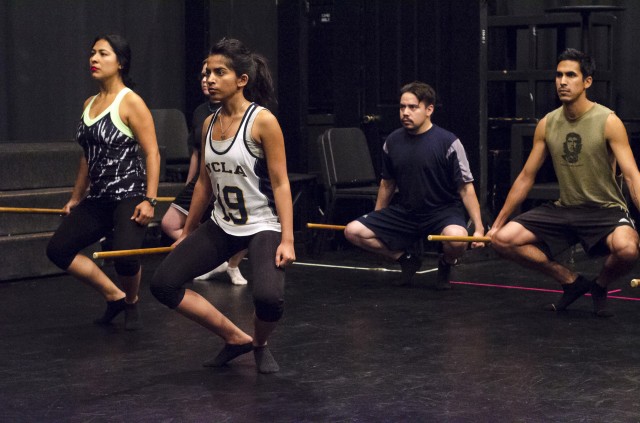It’s been two years since UCLA’s graduate department at the School of Theater, Film and Television accepted any actors into its program.
In the wake of Tony Award-winning Professor Mel Shapiro’s retirement as the head of UCLA’s graduate acting program, Michael Hackett, chairman of the Department of Theater, and other faculty members of the graduate theater department spent two years in search of a new head of acting to recalibrate the program.
After a serendipitous cross-continent interview, Professor J.Ed Araiza, who still maintains his position as a member of New York’s highly respected SITI Company, joined the graduate team of professors alongside theater professors Jose Luis Valenzuela and Edit Villarreal.
This year, for the first time ever, the graduate student playwrights, actors and directors from UCLA’s Department of Theater begin their three-year journey by taking all of their classes together. The recalibrated program also places emphasis on preparing the students for the contemporary theater world.
Araiza has spent the past 20 years as a member of the SITI Company, founded by Anne Bogart, who developed the improvisational, ensemble-building Viewpoints technique, and Tadashi Suzuki, who originated the Suzuki method of physical training for actors. Araiza said his work and discoveries with the company have subsequently had a major influence on the new curriculum of the program.
“The work we do is a holistic approach to being on stage,” Araiza said. “It integrates the body, the breath, a sense of psychology and a sense of physiology as well. What the audience sees is a physical manifestation of your psychology. I don’t know what’s going on in your head, but if I see you nodding or sweating, then I see the physical manifestations.”
The eight actors, three directors and one playwright currently in the program all physically train in the Viewpoint and Suzuki techniques five days a week, two and a half hours a day.
Hackett said this mimics the undergraduate theater department’s “freshman experience,” in which all the freshman theater majors take all of their theater classes together regardless of discipline to gain a greater understand of theater as a whole.
This shift from what has been perceived as a traditional sort of Americanized version of the Stanislavski acting method commonly being taught in most acting schools was in lieu of a challenge left by former professor Shapiro.
“Mel Shapiro sort of challenged us because he said acting is basically taught the same way it was taught a hundred years ago,” Hackett said. “The emphases are in the same places and we haven’t thought perhaps how acting should be taught in the 21st century. So we started thinking about that very actively and it took us two years to find J.Ed.”
Israel López, a graduate student in acting, said this responsive shift in training and emphasis on ensemble work was what drew him to apply to UCLA as an actor already producing his work.
“I think UCLA was intuitive enough to know how the theater world is changing,” López said. “The theater companies that are producing really great works are the theater companies who are producing original scripts and developing this work to form a company that lasts a long time. That’s the reason our directors, actors and playwrights are all in the same room.”
Araiza’s work demands an extreme amount of physical and mental focus from its participants. He said rather than reinforcing the positives that his actors don’t need to work on, he focuses on eliminating their idiosyncratic weaknesses.
“It really pushes me,” said Darcie Crager, a graduate student in directing. “It’s so focus-oriented that you really have to give it your all. You can’t ever go to class and not give it 100 percent because it shows.”
Although Crager is not an actor, she said within just the first three weeks of class, she’s already felt re-inspired as a director.
In addition to Araiza’s movement-based training, Hackett said other restructured elements for the actors include four quarters of acting, voice and movement for the stage and two quarters of acting for the camera. A quarter of acting for the microphone and a quarter of advanced media techniques, which includes green screen and motion capture, is also incorporated.
“It’s not just to introduce students to the techniques of these things, but also to make them think about what the theater of the future is and also in a strange way theater of the past,” Hackett said. “We use the phrase radically ancient and radically modern.”
Araiza also emphasized his desire for the program’s interdisciplinary look and devised work.
He said he wants to prepare his students, classically trained actors, for a contemporary world.
“They’ve got to be able to (do) Shakespeare and the Greeks, but I also want them to be able to do Suzan-Lori Parks. I don’t want them to leave here and be able to do (just) UCLA-style plays,” Araiza said. “I want them to do the kind of work they’re interested in doing.”

